The Journal of the Fantastic in the Arts is soliciting book reviews for various titles and I recently received a list. Following are a few that caught my eye. If only I had more time and funds for my personal library of the fantastic.
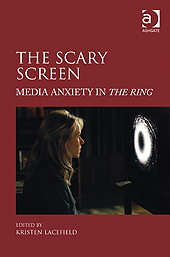 The Scary Screen: Media Anxiety in The Ring, edited by Kristen Lacefield (Ashgate, 2010). In 1991, the publication of Koji Suzuki’s Ring, the first novel of a bestselling trilogy, inaugurated a tremendous outpouring of cultural production in Japan, Korea, and the United States. Just as the subject of the book is the deadly viral reproduction of a VHS tape, so, too, is the vast proliferation of text and cinematic productions suggestive of an airborne contagion with a life of its own. Analyzing the extraordinary trans-cultural popularity of the Ring phenomenon, The Scary Screen locates much of its power in the ways in which the books and films astutely graft contemporary cultural preoccupations onto the generic elements of the ghost story—in particular, the Japanese ghost story. At the same time, the contributors demonstrate, these cultural concerns are themselves underwritten by a range of anxieties triggered by the advent of new communications and media technologies, perhaps most significantly, the shift from analog to digital. Mimicking the phenomenon it seeks to understand, the collection’s power comes from its commitment to the full range of Ring-related output and its embrace of a wide variety of interpretive approaches, as the contributors chart the mutations of the Ring narrative from author to author, from medium to medium, and from Japan to Korea to the United States.
The Scary Screen: Media Anxiety in The Ring, edited by Kristen Lacefield (Ashgate, 2010). In 1991, the publication of Koji Suzuki’s Ring, the first novel of a bestselling trilogy, inaugurated a tremendous outpouring of cultural production in Japan, Korea, and the United States. Just as the subject of the book is the deadly viral reproduction of a VHS tape, so, too, is the vast proliferation of text and cinematic productions suggestive of an airborne contagion with a life of its own. Analyzing the extraordinary trans-cultural popularity of the Ring phenomenon, The Scary Screen locates much of its power in the ways in which the books and films astutely graft contemporary cultural preoccupations onto the generic elements of the ghost story—in particular, the Japanese ghost story. At the same time, the contributors demonstrate, these cultural concerns are themselves underwritten by a range of anxieties triggered by the advent of new communications and media technologies, perhaps most significantly, the shift from analog to digital. Mimicking the phenomenon it seeks to understand, the collection’s power comes from its commitment to the full range of Ring-related output and its embrace of a wide variety of interpretive approaches, as the contributors chart the mutations of the Ring narrative from author to author, from medium to medium, and from Japan to Korea to the United States.
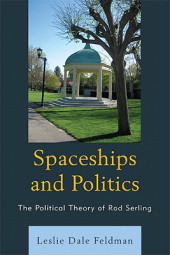 Spaceships and Politics: The Political Theory of Rod Serling, Leslie Dale Feldman (Lexington Books, 2010). Spaceships and Politics: The Political Theory of Rod Serling examines the political themes in The Twilight Zone. In this unique show, Rod Serling used fantasy and the supernatural to explore political ideas such as capital punishment, the individual and the state, war, conformity, the state of nature, prejudice, and alienation. He used aliens and machines to understand human nature. While the themes in The Twilight Zone often reflected political concerns of the time, like the Cold War and post-industrial technology, the messages had broader political implications. This book looks at Serling’s mechanistic view of the world and emphasis on fear through Hobbesian themes like diffidence and automata.
Spaceships and Politics: The Political Theory of Rod Serling, Leslie Dale Feldman (Lexington Books, 2010). Spaceships and Politics: The Political Theory of Rod Serling examines the political themes in The Twilight Zone. In this unique show, Rod Serling used fantasy and the supernatural to explore political ideas such as capital punishment, the individual and the state, war, conformity, the state of nature, prejudice, and alienation. He used aliens and machines to understand human nature. While the themes in The Twilight Zone often reflected political concerns of the time, like the Cold War and post-industrial technology, the messages had broader political implications. This book looks at Serling’s mechanistic view of the world and emphasis on fear through Hobbesian themes like diffidence and automata.
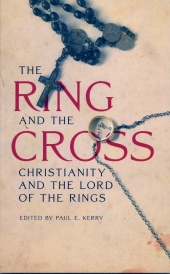 The Ring and the Cross: Christianity and the Lord of the Rings, edited by Paul E. Kerry (Fairleigh Dickinson University Press, 2010). The conversations, sometimes heated, about the influence of Christianity on the writings of J.R.R. Tolkien has a long history. What has been lacking is a forum for civilized discussion about the topic, as well as a chronological and thematic overview of the major arguments that have engaged scholars about the impact of Christianity on Tolkien’s oeuvre, with particular reference to The Lord of the Rings. The Ring and the Cross addresses these needs through articulate and authoritative analyses of Tolkien’s Roman Catholicism and his use of Northern mythology and the role they play in understanding his writings. The volume’s contributors deftly explain the kinds of interpretations put forward and evidence marshaled when arguing for or against religious influence. The Ring and the Cross invites readers to draw their own conclusions about a subject that has fascinated Tolkien readers since the publication of his masterpiece, The Lord of the Rings.
The Ring and the Cross: Christianity and the Lord of the Rings, edited by Paul E. Kerry (Fairleigh Dickinson University Press, 2010). The conversations, sometimes heated, about the influence of Christianity on the writings of J.R.R. Tolkien has a long history. What has been lacking is a forum for civilized discussion about the topic, as well as a chronological and thematic overview of the major arguments that have engaged scholars about the impact of Christianity on Tolkien’s oeuvre, with particular reference to The Lord of the Rings. The Ring and the Cross addresses these needs through articulate and authoritative analyses of Tolkien’s Roman Catholicism and his use of Northern mythology and the role they play in understanding his writings. The volume’s contributors deftly explain the kinds of interpretations put forward and evidence marshaled when arguing for or against religious influence. The Ring and the Cross invites readers to draw their own conclusions about a subject that has fascinated Tolkien readers since the publication of his masterpiece, The Lord of the Rings.
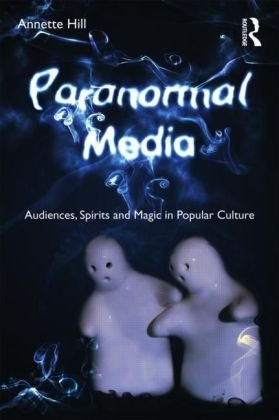 Paranormal Media: Audiences, Spirits and Magic in Popular Culture, Annette Hill (Routledge, 2010). The paranormal has gone mainstream. Beliefs are on the rise, with almost half of the British population, and two thirds of Americans, claiming to believe in extra sensory perceptions and hauntings. Psychic magazines like Spirit and Destiny, television shows such as Fringe, Ghost Whisperer and Most Haunted, ghost-cams and e-poltergeists, bestselling books on mind, body and spirit, and magicians like Derren Brown have moved from the outer limits to the centre of popular culture, turning paranormal beliefs and scepticism into revenue streams. Paranormal Media offers a unique, timely exploration of the extraordinary, unexplained and supernatural in popular culture, looking in unusual places in order to understand this phenomenon. Early spirit forms such as magic lantern shows or the spirit photograph are re-imagined as a search for extraordinary experiences in reality TV, ghost tourism, and live shows. Through a popular cultural ethnography, and critical analysis in social and cultural theory, this ground-breaking book by Annette Hill presents an original and rigorous examination of people’s experiences of spirits and magic. In popular culture, people are players in an orchestral movement about what happens to us when we die. In a very real sense the audience is the show. This book is the story of audiences and their participation in a show about matters of life and death.
Paranormal Media: Audiences, Spirits and Magic in Popular Culture, Annette Hill (Routledge, 2010). The paranormal has gone mainstream. Beliefs are on the rise, with almost half of the British population, and two thirds of Americans, claiming to believe in extra sensory perceptions and hauntings. Psychic magazines like Spirit and Destiny, television shows such as Fringe, Ghost Whisperer and Most Haunted, ghost-cams and e-poltergeists, bestselling books on mind, body and spirit, and magicians like Derren Brown have moved from the outer limits to the centre of popular culture, turning paranormal beliefs and scepticism into revenue streams. Paranormal Media offers a unique, timely exploration of the extraordinary, unexplained and supernatural in popular culture, looking in unusual places in order to understand this phenomenon. Early spirit forms such as magic lantern shows or the spirit photograph are re-imagined as a search for extraordinary experiences in reality TV, ghost tourism, and live shows. Through a popular cultural ethnography, and critical analysis in social and cultural theory, this ground-breaking book by Annette Hill presents an original and rigorous examination of people’s experiences of spirits and magic. In popular culture, people are players in an orchestral movement about what happens to us when we die. In a very real sense the audience is the show. This book is the story of audiences and their participation in a show about matters of life and death.
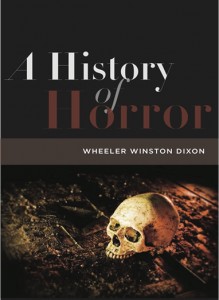 A History of Horror, Wheeler Winston Dixon (Rutgers University Press, 2010). Ever since horror leapt from popular fiction to the silver screen in the late 1890s, viewers have experienced fear and pleasure in exquisite combination. Wheeler Winston Dixon’s A History of Horror is the only book to offer a comprehensive survey of this ever-popular film genre.
A History of Horror, Wheeler Winston Dixon (Rutgers University Press, 2010). Ever since horror leapt from popular fiction to the silver screen in the late 1890s, viewers have experienced fear and pleasure in exquisite combination. Wheeler Winston Dixon’s A History of Horror is the only book to offer a comprehensive survey of this ever-popular film genre.
Arranged by decades, with outliers and franchise films overlapping some years, this one-stop sourcebook unearths the historical origins of characters such as Dracula, Frankenstein, and the Wolfman and their various incarnations in film from the silent era to comedic sequels. A History of Horror explores how the horror film fits into the Hollywood studio system and how its enormous success in American and European culture expanded globally over time.
Dixon examines key periods in the horror film—in which the basic precepts of the genre were established, then burnished into conveniently reliable and malleable forms, and then, after collapsing into parody, rose again and again to create new levels of intensity and menace. A History of Horror, supported by rare stills from classic films, brings over fifty timeless horror films into frightfully clear focus, zooms in on today’s top horror Web sites, and champions the stars, directors, and subgenres that make the horror film so exciting and popular with contemporary audiences.





Here is another good book on the topic: The Fantasy Book: An Illustrated History from Dracula to Tolkein, Franz Rottensteiner, Collier, 1978. It’s likely out of print, but worth looking for in libraries, etc. It’s a coffee-table book with lots of neat illustrations, and an intelligent, broad survey of various kinds of fantasy, ranging from Poe, Lovecraft, Lewis Carroll, Tolkein, C.S. Lewis, etc. . It’s good both as an introduction to fantasy, and for long-time devotees.
Thanks for another great recommendation.